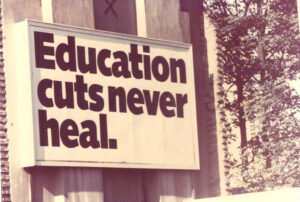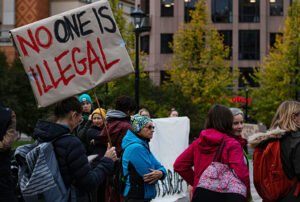
The election of powerhouse women of color to Congress has ignited the hopes of grassroots social change movements. Of course, already it’s clear that moving from electoral victory to long-term change is challenging. How can we help movement-driven candidates realize their promise? And how can this lead to lasting change in people’s lives?
Nashville and San Jose, two cities on opposite sides of the country, offer insight into both questions. Stand Up Nashville (SUN) and Silicon Valley Rising (SVR) have faced juggernauts of the current global economy—Amazon (and finance capital) on one end and real estate development on the other—and held their ground. They have done so while reworking the relationship between their city halls and administrations and the grassroots, including by helping advance progressive elected officials.
Informing both cities is a model of developing leaders and regional “governing coalitions” for change. In our recent report, we document some key elements that drive success. We flesh out the work of the 1000 Leaders Project, developed by Working Partnerships USA, as well emerging groups like the Oregon Futures Lab. These organizations are honing a training and coalition model to reshape governance and address gentrification, inequality, racist and anti-immigrant policies, and other harms to low-income communities of color.
Cities on the Verge
Silicon Valley and Nashville are connected in perhaps-unexpected ways: both are sites of massive economic development that has left local residents behind. Working class, often immigrant and Black residents, may do the hard, invisible work that keeps tech companies (in San Jose) or massive healthcare services (in Nashville) moving, but their wages are often low, and they increasingly cannot live in the places they work. It’s not a West Coast or Southern story: it’s more and more a 21st-century US story.
In San Jose, such crises spurred the creation of SVR in 2015, linking community, labor, faith-based, and service groups. SVR came directly out of several cohorts of training by 1000 Leaders, a Working Partnerships program that provides trainings that have strengthened the capacity of leaders and organizations to govern collectively on a range of issues. This includes both grassroots leaders who will run for or who are already in office and ties to a broader strategy in tandem with outside organizing efforts. In 2016, support from labor and progressive movements helped propel two young progressives, Sergio Jimenez and Sylvia Arenas, to win seats on San Jose’s City Council.
Among the biggest issues on the agenda were affordable housing and tenant protections. At the time, while rent control limited rent increases to five percent, landlords were permitted to “bank” raising rent—meaning a landlord could hold off on raising rents several years in a row, then add those “missed” years’ raises all at once down the line, rendering rent unaffordable overnight.
Landlord associations like the California Apartment Association are powerful in the state. Supporting limits on their power often seems nearly impossible, especially in overheated housing markets. Nonetheless, SVR was ready to try.
Across the country, in Nashville, SUN, a newer yet similar coalition to SVR, sought to change how development in its hometown worked. The City had often provided massive tax and cash incentives, including per-promised-jobs grants to out-of-town companies. Yet jobs were slow to come, even as gentrification came quickly.
After building a deep base among economically distressed residents, SUN put the Do Better Bill before the Metro Council. This requires that any major developments that receive financial incentives from the City enumerate exactly how they will benefit the city. Details required include how many locals the company receiving incentives plan to hire and in what salary ranges. “Companies are graded,” SUN’s Co-Chair Odessa Kelly explained, “on how well they would contribute to the city.”
In early 2018, Do Better passed—a clear victory for SUN. But the win was just step one. The first test of Do Better came when AllianceBernstein, a New York-based private company that manages an estimated $581 billion in assets, decided to move its multi-billion dollar headquarters to Nashville in exchange for an originally undisclosed amount. The next: Amazon, fresh from a defeat in New York, promising to build its gargantuan HQ2. The massive corporation was fishing for even larger incentives, but with even less transparency.
Movements in both cities had monumental tasks before them, not the least of which was shifting the priorities of their local governments to promote the well-being of low-income communities of color, not just corporations. Our research team captured three key elements in the ways leaders were trained and worked together—ones that we also saw in New Haven, across Oregon, and in other sites we studied—that helped move the collective “inside” and “outside” agenda for change forward in San Jose and Nashville. These elements, our research shows, can become the bedrock for longer-term change of how governance works—and for whom.
Leading Collectively
No one person, not even an elected official, can take on Amazon or the California Apartment Association alone, much less issues like inequality. Knowing this, programs like 1000 Leaders help foster a collective approach to leadership. In this, “inside” and “outside” voices work collaboratively in ways that prioritize marginalized communities. As Working Partnerships Executive Director Derecka Mehrens summed it up, 1000 Leaders reframes leadership as “the art of making others successful.”
Both 1000 Leaders and Oregon Futures Lab have forged these relationships via cohort-based models. Leaders grow and learn together during short-term trainings. Local organizations recruit and select their own participants—often people of color, women, LGBTQ, and other communities excluded from power. In the workshop settings, they meet other movement-oriented leaders from similar communities who have successfully moved into positions of influence ranging from campaign leadership to organizational leadership to elected office.
San Jose City Councilmember Sergio Jimenez, one of that city’s newest elected officials, participated in several 1000 Leaders trainings that helped him move from resident organizing to parks administration and, now, elected office. It also gave him long-lasting relationships with outside groups that continue to inform his work.
In Nashville, when SUN began training its members, the goal was more to build among “outside” grassroots groups that were at different stages of building power. The result of the work was similar: creating a “governing coalition” that can jointly advance a shared vision and tangibly build power for communities.
Leading with Values
The “glue” of a governing coalition is values. Trainings help participants concretely recognize the commitments that drive them, and how they link to their cultural and social positions and experiences. For example, “Me-Tree” exercises allow leaders to see how they and their colleagues’ cultural and social background (“the roots”) informs the work they have done and changes they envision (“the branches” and “fruit”). To help move from the individual to the collective, 1000 Leaders trainers also help the cohort create a common values-based platform.
A values-based approach cemented the work to redefine San Jose’s tenant protections and helped propel efforts beyond the rent control “banking” protections. After communities won this legislation in a close vote, they launched a campaign to pursue a much harder-to-win “just cause” eviction policy. For Jimenez, the decision to take on broader reaching change was rooted in his own experiences. “I grew up in an affordable housing complex. Although very poor we benefitted from having stable housing that allowed my mom to really provide the basic needs of her family.” At public meetings, residents appealed to understandings of how housing can affect family prospects.
Sign up for our free newsletters
Subscribe to NPQ's newsletters to have our top stories delivered directly to your inbox.
By signing up, you agree to our privacy policy and terms of use, and to receive messages from NPQ and our partners.
In Working Partnerships Policy Director Jeffrey Buchanan’s words, advancing a difficult-to-win but crucial policy meant “leading with their values.” Buchanan notes that rooting inside leaders and outside groups in a collective values-based platform helped “change the thoughts on what is possible.”
Values-driven approaches also help hold governing coalitions together through the ups and downs of issue campaigns, elections, and more. Kelly explained that in building this collective approach, “things are going to get hard, but we [at SUN] have learned to check in with each other across organizations, take a deep breath, and remember our bigger purpose.”
For SUN, as Kelly notes, a key result of its work is defining and emphasizing values like transparency and integrating them into local decision-making. The conversation has already changed in important ways: Many leaders now run on transparency platforms. Even as policymakers waffled on their approach to Amazon, they had to address the values of transparency in a substantive way. They had to be ready to explain to constituents when they would show up to local faith-based and community institutions after being elected why they would trade the values they espoused for vague promises from large corporations.
Leading toward Governing Power
When you place fresh, movement-backed leaders like Jimenez in office, or when you delve into implementing policy like SUN did, there can be a wide knowledge gap to bridge. Much of the nuts-and-bolts of the “inside” is inaccessible outside of elite circles. So, training leaders on the technical workings of government, like Robert’s Rules of Order, is crucial to moving policy. These tools help leaders engage in mundane, complex, but crucial processes like budgeting.
Elected progressive leaders also learn how to govern from “behind the dais.” This looks different from community organizing, as it involves listening to constituents, determining how to get votes through, and/or moving administrative bodies to take action.
Training helps a governing coalition see the full picture of government, taking seriously staff and appointed positions. “Once you are on the inside, you realize some of the people who hold power are the chiefs of staff, the behind the-scenes policy experts,” Oregon Futures Lab’s Director Ana del Rocío explained. “You have to understand how power is wielded in these relationships to disrupt it more effectively.”
In Nashville, as grassroots activists pursued the Do Better Bill, organizers worked hard to move staff on the inside. They identified the Mayor’s Economic and Community Development (ECD) agency as a key organization with which to build relationships. Clerks and other officials in the ECD, according to Kelly, have proven crucial to implement Do Better and to call out Amazon when it fails to comply.
Bringing It All Together
These governing coalitions learn how to work strategically together. Inside leaders have invited grassroots groups to claim a seat at the policy table to share their expertise and research. When they are not being heard, outside movements strategically work to drive home the message through media, rallies, and other creative actions and protests.
When AllianceBernstein first provided its disclosures, SUN pushed administrators to ask for more and engaged in a back-and-forth that led to much more concrete commitments. Amazon was far more recalcitrant, providing vague promises of jobs that paid an average of $150,000 and high percentages of local hiring. Community suspected this number was skewed by the company’s high pay for executives, with no details on where and how local residents would be hired. SUN member organizations helped translate the data for communities and brought the lack of real transparency to the media, leading to new public pushback—including from Council.
In the case of Silicon Valley, the coalition initially faced stepped-up opposition by the California Apartment’s Association. But by publishing data illustrating the burdens of current housing policy on renters, sharing stories in the media, and organizing direct action, they shifted the requisite votes and built public understanding.
Growing the Movement
A governing coalition’s work is long term. With its Do Better Bill, Nashville organizers now have data to hold these large corporations accountable, which can later become the grounds for withholding incentives and demanding community benefits.
For a number of SUN members, the gap between the rhetoric and action on transparency by some council members has now motivated them to run for Metro Council under a Justice League PAC this summer, which has endorsed 15 candidates. SUN itself is not running or endorsing any candidates, but it has offered a space to build a common, values-based platform and a way to deepen understanding of governance.
In Silicon Valley, in late 2017, organizers won “just cause” legislation, which protects tenants from being evicted without the landlord clearly stating a valid reason for their eviction. “Really working together and trusting each other was key to success,” Buchanan noted, both on the inside and outside. Officials like Councilmembers Jimenez, Maya Esparza, Raúl Peralez, and Magdalena Carrasco continue to show leadership on issues of equity beyond housing in dialogue with SVR. At the County level, their efforts are matched by Santa Clara County Supervisor (and 1000 Leaders co-founder) Cindy Chavez, who helped pass a $950 million affordable housing bond in 2016 and who is now helping track and ensure its equitable implementation.
Meanwhile, work continues to develop ways to support governing coalitions for the long-term through mechanisms like alumni networks and ongoing training. As Rocío notes, and as racist invectives against women of color legislators from top Republicans confirm, new faces in power can face verbal and sometimes even physical violence. Rocío says in response her group in Oregon is piloting a Healing Leaders Project that provides culturally relevant mental and spiritual care and spaces for dialogue to help officials sustain the emotional burden of working on the inside.
Governing coalition work also raises the importance of robustly engaging in inside and outside work, including widening knowledge of 501c3 (which forbids direct electoral work for leaders) and 501c4 (or PAC) mechanisms, which of course permit such work.
If Nashville and San Jose are any indication, while the struggle is long-term, new leaders are rising every day—hungry for the knowledge, skills, and space to put their values into practice.








